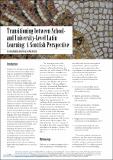Files in this item
Transitioning between school- and university-level Latin learning : a Scottish perspective
Item metadata
| dc.contributor.author | Buckley, Emma | |
| dc.contributor.author | König, Alice | |
| dc.contributor.author | Kotarcic, Ana | |
| dc.date.accessioned | 2017-05-16T12:30:10Z | |
| dc.date.available | 2017-05-16T12:30:10Z | |
| dc.date.issued | 2017-05-11 | |
| dc.identifier | 249568422 | |
| dc.identifier | ec34f7e6-8eb3-4aa9-bd50-1c54c725c7ec | |
| dc.identifier | 000401150800008 | |
| dc.identifier.citation | Buckley , E , König , A & Kotarcic , A 2017 , ' Transitioning between school- and university-level Latin learning : a Scottish perspective ' , Journal of Classics Teaching , vol. 18 , no. 35 , pp. 54-64 . https://doi.org/10.1017/S2058631017000083 | en |
| dc.identifier.other | ORCID: /0000-0002-7937-9134/work/60195516 | |
| dc.identifier.other | ORCID: /0000-0002-0245-5303/work/61622279 | |
| dc.identifier.uri | https://hdl.handle.net/10023/10783 | |
| dc.description | This project was funded by the University of St Andrews’ Strategic Enhancement of Learning Fund (SELF). It was also generously supported by the School of Classics at St Andrews, with active involvement from many St Andrews colleagues. | en |
| dc.description.abstract | Students are arriving to study Latin at university with an increasingly diverse range of qualifications (including no Latin at all). This is something to celebrate. University Classics departments want students from different educational backgrounds; and we want a wide range of qualification authorities to continue to offer students the chance to start learning Latin at school. This diversity is being exacerbated, however, by an increasingly stark differential in the content and rigour of these various qualifications; and that presents challenges for universities aiming to integrate students quickly and acclimatise them to university-style learning. Classes in all subjects have more and less knowledgeable students learning side-by-side; but the dynamics of a Latin language class mean that gaps in knowledge and differences in experience become publicly visible very quickly. This is thus a social problem as much as it is an academic one, and it is particularly acute during that important period of transition, the first year of university study. This trend is not exclusive to the teaching of Latin but has also been a recurring theme of discussion within Modern Languages too, particularly in Scottish universities where the percentage of non-A Level students is higher than is generally the case south of the border. | |
| dc.format.extent | 11 | |
| dc.format.extent | 1775018 | |
| dc.language.iso | eng | |
| dc.relation.ispartof | Journal of Classics Teaching | en |
| dc.subject | LB1603 Secondary Education. High schools | en |
| dc.subject | LB2300 Higher Education | en |
| dc.subject | D History (General) | en |
| dc.subject | NDAS | en |
| dc.subject.lcc | LB1603 | en |
| dc.subject.lcc | LB2300 | en |
| dc.subject.lcc | D1 | en |
| dc.title | Transitioning between school- and university-level Latin learning : a Scottish perspective | en |
| dc.type | Journal article | en |
| dc.contributor.institution | University of St Andrews. School of Classics | en |
| dc.contributor.institution | University of St Andrews. Centre for the Literatures of the Roman Empire | en |
| dc.contributor.institution | University of St Andrews. Centre for the Study of Ancient Systems of Knowledge | en |
| dc.contributor.institution | University of St Andrews. St Andrews Institute of Medieval Studies | en |
| dc.identifier.doi | 10.1017/S2058631017000083 | |
| dc.description.status | Peer reviewed | en |
This item appears in the following Collection(s)
Items in the St Andrews Research Repository are protected by copyright, with all rights reserved, unless otherwise indicated.

